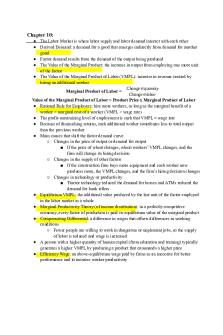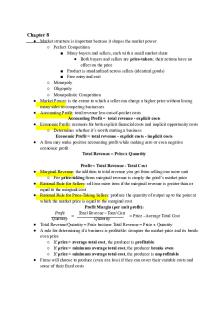Econ micro essay cigarettes PDF

| Title | Econ micro essay cigarettes |
|---|---|
| Course | Economics - A2 |
| Institution | Sixth Form (UK) |
| Pages | 2 |
| File Size | 85.7 KB |
| File Type | |
| Total Downloads | 21 |
| Total Views | 176 |
Summary
Cigarettes on microeconomics...
Description
Evaluate the Impact of Government intervention in the cigarette market
The cigarette market is one which causes much controversy around it’s impacts that it brings about for the economy. It is argued often that the negative effects bought about by having such a market often exceed the positive ones. For example It is quite well known that the price elasticity of demand for cigarettes is inelastic and thus the incidence of tax is borne by consumers more so than by the firms that produce the cigarettes themselves thus, in this way the consumption of cigarettes by individuals is seen as generating greater revenue for the government however the negative externalities bought about by the consumption of cigarettes i.e passive smoking, is shown to have a considerable burden on the NHS and the number of smoking-related admissions has increased year on year, treatment is costly per admission and thus the overall costs of treatment on the NHS may exceed the extra revenue bought in from the consumption of cigarettes. This is just one controversial issue facing the cigarette market not just in the UK but worldwide. Welfare loss to society from negative externalities of cigarettes Cigarettes contain tobacco which is essentially addictive and thus user find themselves compelled to purchase more and more hence the reason for cigarettes being demand inelastic (PED -0.35) this essentially means that at higher prices demand is not as responsive to the change in price.There are many habitual users who regardless of the cost continue to purchase cigarettes. The price of a packet of 20 cigarettes ranges from £7.70 to £9.50. This price is relative to consumers income however generally it is seen as quite expensive especially to those from a low-income background. People from lower classes who smoke are hit the hardest by the cost of the cigarettes and when the government implements higher taxes on cigarettes this has the greatest effect on lower-income backgrounds. Government intervention on cigarettes ultimately arises for two reasons, one of which may be to generate extra revenue for the government, this additional revenue can then be spent in areas which need to be improved upon e.g infrastructure, schooling the police force. The second reason for intervention is to try and reduce the negative effects especially to one’s health of smoking. In the passage it states that ‘Tobacco taxes are the most cost- effective way to reduce tobacco use, especially among the young and people in low-income groups. A tax increase that raises tobacco prices by 10 percent decreases tobacco consumption by 4 percent in high income countries and 5 percent in low and middle income countries’. Although this statistic shows a positive outcome initially, in the long term it is dependent on how far addicted each individual is to tobacco as stated before cigarettes have a relatively inelastic demand so in the short term higher prices may deter people consuming only for so long. However in the long term taxation is not as efficient an approach as consumers will continue purchasing cigarettes due to their addictive nature.
emand is not responsive to a change in price due to addictive nature of cigarettes PED -0.35
Government intervention on cigarettes is not just through taxation, cigarette packets now show graphic photos of the harmful consequences on smoking ,many are labelled with negative slogans of what ultimately may happen in the long term if you continue smoking however again due to the addictive nature of tobacco in cigarettes this has not proven that effectively. Compared with taxation though there has been some positive outcome in this scheme in which numbers have
shown that their has been an increase in smokers wanting to quit and phoning up helplines. Statistics show that 8 million people are expected to die each year by 2030 because they have smoked tobacco or been exposed to passive smoking. This statistic can be seen in two ways one of which is there will be a greater loss of revenue to the government from this, the second is that this statistic can be used to show younger generations of the effects of smoking in the hope that it may deter them from the consumption of cigarettes later on in life. The introduction of e-cigarettes on the market is seen as equally controversial to the use of traditional tobacco cigarettes. Nowadays we see e-cigarettes being marketed and advertised almost everywhere, it’s prominence and use has risen through the years especially in the early 2000s. E-cigarettes boast about helping smokers to eventually cut their ties with traditional tobacco cigarettes and boast better health benefits when consuming them, however the likelihood of this is uncertain as their is no real scientific evidence to back up this claim. The nicotine dispensed by the e-cigarettes is very addictive and although e-cigarettes give off the impression that they have less of a profound effect on your health than a traditional cigarette, the use of e-cigarettes may eventually lead individuals into smoking normal cigarettes and so in the long term this approach may backfire. However it could be the case that the government could effectively back e-cigarette consumption in the hope that traditional smokers will switch to this method however the unintended consequences are unknown and so this measure would prove ineffective. The price of e-cigarette kits range from £9.99-19.99 and the price elasticity of demand is -1.9 making the product relatively more price elastic than tobacco cigarettes this means that tax would have little effect on consumers and more of an effect on firms meaning that revenue is drawn in through taxing traditional cigarettes more than e-cigarettes.
In conclusion, government intervention in the cigarette market may prove ineffective through various different approaches in trying to reduce the number of people smoking i.e through taxation due to the addictive nature of the cigarette and the fact that this means that cigarettes have an inelastic demand. Again the government has banned smoking in the UK in public places in attempt to reduce second hand smoking but passive smoking related admissions to hospitals are on the rise and the costs to the NHS are far greater than the revenue bought in through taxation. Due to the addictive nature of tobacco individuals may find it very hard to come off them and with any addiction this is deemed true thus the government may find it helpful to target early intervention with more of an emphasis on educating younger generations in schools for example. From studies today, it is shown that early intervention is key to overcoming addition and thus if the government aims their campaigns towards the younger generations this could prevent many people from starting up smoking, by showing what profound effects smoking has towards a younger audience may deter any consumption of tobacco products however the government must take into account the admin costs of enforcing these campaigns as if the costs are too high and it turns out that the campaign proved ineffective this is wasted funding and could be put towards better use at trying to deter individuals from smoking. Furthermore government intervention could distort market prices and thus eventually lead to market failure where black markets although already around in the tobacco industry can become more prominent and start to cause greater problems thus the government must be careful in that sense so as not to disrupt market pricing too much. The best approach would to be to target campaigns towards younger audiences however their is only so much the government can do and the addictive nature of this product as with any additive product proves further of a barrier in trying to target individuals to stop smoking.
Simran...
Similar Free PDFs

Econ micro essay cigarettes
- 2 Pages

Micro Econ Concept Map
- 3 Pages

Micro Econ 2100 Exam 2
- 14 Pages

ECON.1209.221 - T3 de Micro.
- 9 Pages

Quick Study Micro Econ 1
- 5 Pages

ECON 2102 Essay #1
- 2 Pages
Popular Institutions
- Tinajero National High School - Annex
- Politeknik Caltex Riau
- Yokohama City University
- SGT University
- University of Al-Qadisiyah
- Divine Word College of Vigan
- Techniek College Rotterdam
- Universidade de Santiago
- Universiti Teknologi MARA Cawangan Johor Kampus Pasir Gudang
- Poltekkes Kemenkes Yogyakarta
- Baguio City National High School
- Colegio san marcos
- preparatoria uno
- Centro de Bachillerato Tecnológico Industrial y de Servicios No. 107
- Dalian Maritime University
- Quang Trung Secondary School
- Colegio Tecnológico en Informática
- Corporación Regional de Educación Superior
- Grupo CEDVA
- Dar Al Uloom University
- Centro de Estudios Preuniversitarios de la Universidad Nacional de Ingeniería
- 上智大学
- Aakash International School, Nuna Majara
- San Felipe Neri Catholic School
- Kang Chiao International School - New Taipei City
- Misamis Occidental National High School
- Institución Educativa Escuela Normal Juan Ladrilleros
- Kolehiyo ng Pantukan
- Batanes State College
- Instituto Continental
- Sekolah Menengah Kejuruan Kesehatan Kaltara (Tarakan)
- Colegio de La Inmaculada Concepcion - Cebu









